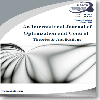The structure of one weight linear and cyclic codes over Zr 2 × (Z2 + uZ2)s
The structure of one weight linear and cyclic codes over Zr 2 × (Z2 + uZ2)s
___
- Hammons, A. R., Kumar, V., Calderbank, A. R., Sloane, N.J.A. and Sol´e, P. (1994). The Z4-linearity of Kerdock, Preparata, Goethals, and related codes. IEEE Trans. Inf. Theory, 40, 301-319.
- Calderbank, A.R. and Sloane, N.J.A. (1995). Modular and p-adic cyclic codes. Designs, Codes and Cryptog- raphy, 6, 21-35.
- Greferath, M. and Schmidt, S. E. (1999). Gray isome- tries for finite chain rings. IEEE Trans. Info. Theory, 45(7), 2522-2524.
- Honold, T. and Landjev, I. (1998). Linear codes over finite chain rings. In Optimal Codes and Related Top- ics, 116-126, Sozopol, Bulgaria.
- Borges, J., Fern´andez-C´ordoba, C., Pujol, J., Rif`a, J. and Villanueva, M. (2010). Z2Z4-linear codes: Gener- ator Matrices and Duality. Designs, Codes and Cryp- tography, 54(2), 167-179.
- Aydogdu, I. and Siap, I. (2013). The structure of Z2Z2s−Additive codes: bounds on the minimum distance. Applied Mathematics and Information Sci- ences(AMIS), 7(6), 2271-2278.
- Aydogdu, I. and Siap, I. (2015). On ZprZps -additive codes. Linear and Multilinear Algebra, , 63(10), 2089- 2102.
- Abualrub, T., Siap, I. and Aydin, N. (2014). Z2Z4- additive cyclic codes. IEEE Trans. Inf. Theory, 60(3), 1508-1514.
- Dougherty, S.T., Liu, H. and Yu, L. (2016). One Weight Z2Z4 additive codes. Applicable Algebra in En- gineering, Communication and Computing, 27, 123- 138.
- Carlet, C. (2000). One-weight Z4-linear codes, In: Buchmann, J., Høholdt, T., Stichtenoth, H., Tapia- Recillas,H. (eds.) Coding Theory, Cryptography and Related Areas. 57-72. Springer, Berlin.
- Wood, J.A.(2002) The structure of linear codes of con- stant weight. Trans. Am. Math. Soc. 354, 1007-1026.
- Skachek, V. and Schouhamer Immink, K.A. (2014). Constant weight codes: An approach based on Knuth’s balancing method. IEEE Journal on Selected Areas in Communications, 32(5), 909-918.
- Telatar, I.E. and Gallager, R.G (1990). Zero error de- cision feedback capacity of discrete memoryless chan- nels. in BILCON-90: Proceedings of 1990 Bilkent In- ternational Conference on New Trends in Communi- cation, Control and Signal Processing, E. Arikan, Ed. Elsevier, 228-233.
- Dyachkov, A.G. (1984). Random constant compo- sition codes for multiple access channels. Problems Control Inform. Theory/Problemy Upravlen. Teor. In- form., 13(6), 357-369.
- Ericson, T. and Zinoviev, V. (1995). Spherical codes generated by binary partitions of symmetric point sets. IEEE Trans. Inform. Theory, 41(1), 107-129.
- King, O.D. (2003). Bounds for DNA codes with con- stant GC-content. Electron. J. Combin., 10(1), Re- search Paper 33, (electronic).
- Milenkovic, O. and Kashyap, N. (2006). On the design of codes for DNA computing. Ser. Lecture Notes in Computer Science, vol. 3969. Berlin: Springer-Verlag, 100-119.
- Colbourn, C. J., Kløve, T. and Ling, A. C. H. (2004). Permutation arrays for powerline communication and mutually orthogonal Latin squares. IEEE Trans. In- form. Theory, 50(6), 1289-1291.
- Abualrub, T. and Siap, I. (2007). Cyclic codes over the rings Z2 + uZ2 and Z2 + uZ2 + u2Z2. Designs Codes and Cryptography, 42(3), 273-287.
- Al-Ashker, M. and Hamoudeh, M. (2011). Cyclic codes over Z2 + uZ2 + u2Z2 + · · · + uk−1Z2. Turk. J. Math., 35, 37-749.
- Dinh, H. Q. (2010). Constacyclic codes of length ps over Fpm + uFpm. Journal of Algebra, 324, 940-950. [22] Bonisoli, A. (1984). Every equidistant linear code is a sequence of dual Ham- ming codes. Ars Combin., 18, 181-186.
- Aydogdu, I., Abualrub, T. and Siap, I. (2015). On Z2Z2[u]−additive codes. International Journal of Computer Mathematics, 92(9), 1806-1814.
- Aydogdu, I., Abualrub, T. and Siap, I. (2017). Z2Z2[u]-Cyclic and constacyclic codes. IEEE Trans. Inf. Theory, 63(8), 4883-4893.
- Van Lint, J.H. (1992). Introduction to Coding Theory. Springer-Verlag, New York.
- Grassl, M., Code tables: Bounds on the parameters of various types of codes. Online database. Available at http://www.codetables.de/
- ISSN: 2146-0957
- Yayın Aralığı: 4
- Yayıncı: Prof. Dr. Ramazan YAMAN
On discrete time infinite horizon optimal growth problem
A decoupled Crank-Nicolson time-stepping scheme for thermally coupled magneto-hydrodynamic system
The structure of one weight linear and cyclic codes over Zr 2 × (Z2 + uZ2)s
A hybrid QFD-AHP methodology and an application for heating systems in Turkey
Hüseyin BAŞLIGİL, Pelin ALCAN, YAVUZ ÖZDEMİR, Dursun ÇAKRAK
Analysis of rubella disease model with non-local and non-singular fractional derivatives
